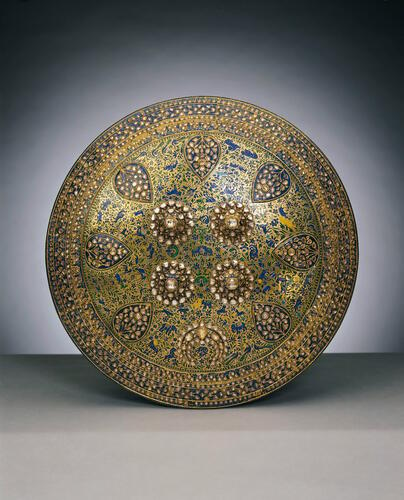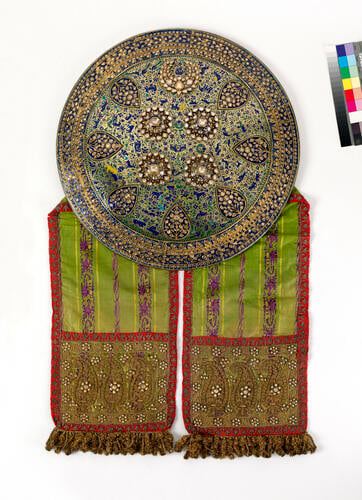-
1 of 253523 objects
Dhal (shield) 1800-75
Silver gilt, brass, enamel and diamonds | 6.7 x 48.0 cm (whole object) | RCIN 11278


-
Like the weapons and other articles presented to Albert Edward Prince of Wales during his four-month tour of India in 1875-76, this is a particularly elaborate and rich example of a traditional form. Shields of this type, or dhal, were usually made of hide, often painted or lacquered, with metal bosses applied at the points to which the handles were fastened on the reverse. In this instance the front of the shield is made of silver gilt, enamelled in blue, green and yellow, mounted with four bosses and inset with seven tear-shaped ornaments and a crescent motif, all of them set with diamonds. This impressive shield is inlaid with more than 800 diamonds.
The colours employed for the enamelling, and the subject matter - numerous animals and birds, some of which are attacking one another - are characteristic of Lucknow work of the eighteenth and nineteenth centuries. The four jewelled borders around the edges are formed on segmental plates about 20 centimetres long, whose joins are disguised in ingenious ways. The thickness of the shield is probably filled with lac, and the reverse is silver-gilt.
Provenance
Presented to King Edward VII, when Prince of Wales, during his tour of India in 1875-76 by Ranbir Singh, Maharaja of Kashmir.
-
Medium and techniques
Silver gilt, brass, enamel and diamonds
Measurements
6.7 x 48.0 cm (whole object)
Category
Object type(s)
Alternative title(s)
Shield
Dhal
Place of Production
Lucknow [Uttar Pradesh]